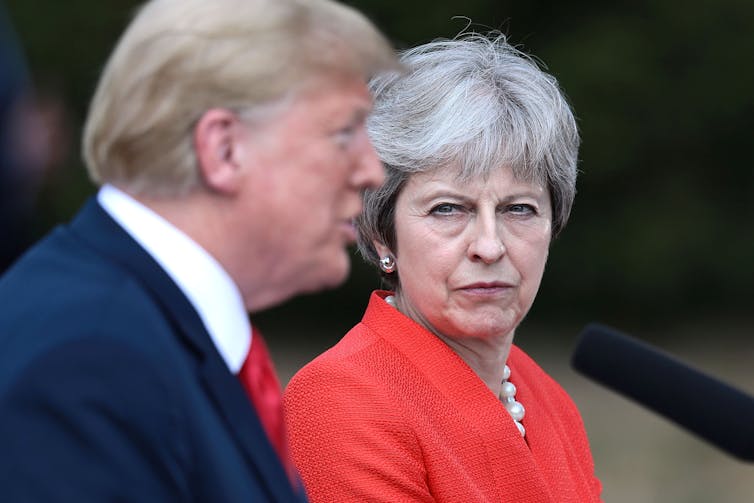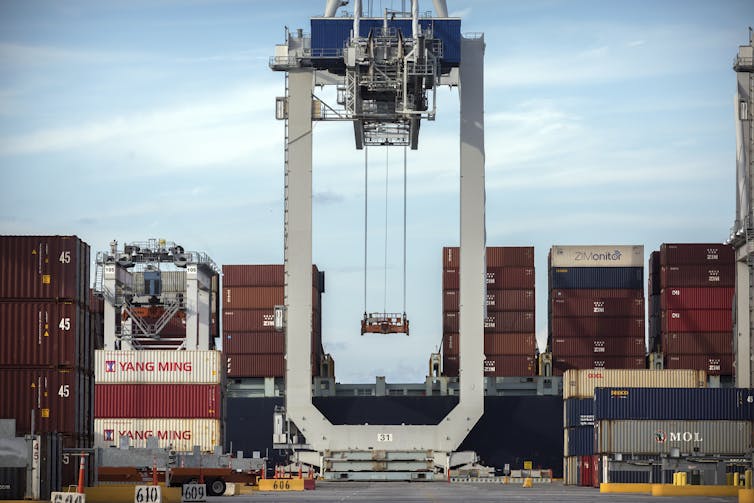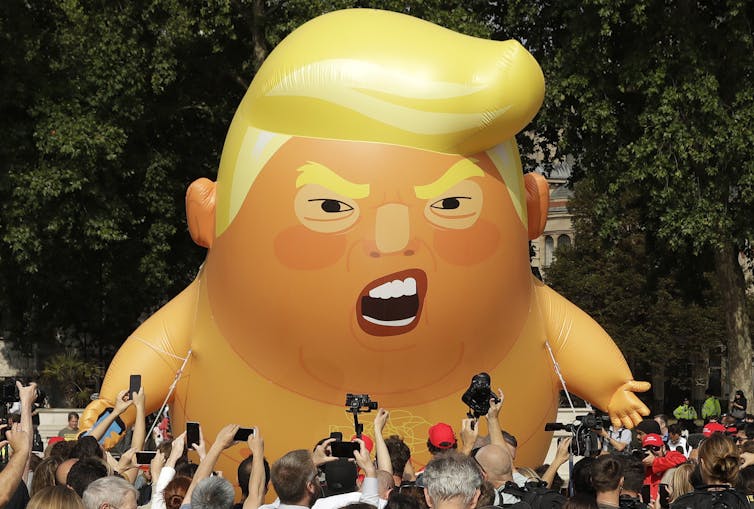The US is a whole lot richer because of trade with Europe, regardless of whether EU is friend or 'foe'
- Written by Greg Wright, Assistant Professor of Economics, University of California, Merced
President Donald Trump recently questioned the value of the long-standing United States-Europe alliance. When asked to identify his “biggest foe globally,” he declared[1]: “I think the European Union is a foe, what they do to us in trade.”
This view is consistent with his recent turn against trade[2] with Europe but ignores the immense benefits that Americans have reaped due to the strong economic and military alliance between the U.S. and Europe – benefits that include nothing less than unprecedented peace[3] and prosperity[4].
As such, Trump’s trade war[5] with Europe and his hostility toward broader Western alliances such as NATO portend a future of diminished standards of living – as a direct result of less trade – and greater global conflict – indirectly due to[6] reduced economic integration. In the words of columnist Robert Kagan, “things[7] will[8] not be ok[9].”
Some of my research[10] focuses on the impact of increased international trade on U.S. standards of living, which I show[11] are causally linked during the late 20th century. Most of the trade in this period occurred among rich nations and was dominated by the U.S.-Europe relationship.
By calling Europe a “foe,” Trump makes clear that he simply doesn’t understand why rich countries trade with one another, which, to be fair, is something that also puzzled economists for many years.
 Trump and one of his ‘foes.’
Reuters/Jack Taylor[12]
Trump and one of his ‘foes.’
Reuters/Jack Taylor[12]
Why rich countries trade
Though in some ways it seems obvious why the U.S. and Europe trade with one another – some might enjoy Parmigiana from Italy, while others prefer Wisconsin cheddar – economists initially had trouble[13] explaining exactly why there was so much trade among rich countries. Surely, they thought, the U.S. can produce good quality cheese at a cost that is similar to producers in Italy, and vice versa, so why would we need to go abroad to satisfy our palettes?
In 1979, economist Paul Krugman provided a clear answer that would eventually win him[14] the Nobel Prize in economics. The first part of his answer was simple but important and boils down to the fact that consumers benefit from having a wide range of product varieties available to them, even if they are only small variations on the same item.
For instance, in 2016[15] the top U.S. exports to the EU were aircraft (US$38.5 billion), machinery ($29.4 billion) and pharmaceutical products ($26.4 billion). The top imports from the EU seem almost identical: machinery ($64.9 billion), pharmaceutical products ($55.2 billion) and vehicles ($54.6 billion). Although the product categories clearly overlap, there are important differences in the types of pharmaceuticals and machinery that are sold in each market. Consumers benefit from having all these options available to them.
The second part of Krugman’s answer was that, by producing for both markets, companies in Europe and the U.S. could reap greater economies of scale in production and lower their prices as a result. This has been found to indeed be what happens[16] when countries trade. And more recent research[17] has shown that increased foreign competition can also lower domestic prices.
These benefits have been quantified. For instance, the gains to the U.S. from new foreign product varieties and lower prices over the period 1992 to 2005 were equal to about one percent of U.S. GDP[18] – or about $100 billion.
In short, Krugman’s answer emphasized the extent to which international trade between equals increases the overall size of the economic pie. And no pie has ever grown larger than the combined economies of the U.S. and Europe, which now constitute[19] half of global GDP.
 Pfizer Inc. is headquartered in New York. Both the U.S. and the EU import and export pharmaceuticals.
AP Photo/Richard Drew[20]
Pfizer Inc. is headquartered in New York. Both the U.S. and the EU import and export pharmaceuticals.
AP Photo/Richard Drew[20]
Largest trading partner
The European Union[21] is the largest U.S. trading partner in terms of its total bilateral trade and has been for the past several decades.
Overall, the U.S. imported $592 billion[22] in goods and services from the EU in 2016 and exported $501 billion, which represents about 19 percent of total U.S. trade and also represents about 19 percent of American GDP.
A key feature of this trade is that almost a third of it[23] happens within individual companies. In other words, it reflects multinational companies shipping products to themselves in order to serve their local market, or as inputs into local production. This type of trade is critical as it serves as the backbone of a vast network[24] of business investments on both sides of the Atlantic, supporting[25] hundreds of thousands of jobs.
It is also a network that propels the global economy: the EU or U.S. serves as the primary trading partner for nearly every country on Earth.
 A ship to shore crane prepares to load a shipping container onto a container ship in Savannah, Ga.
AP Photo/Stephen B. Morton[26]
A ship to shore crane prepares to load a shipping container onto a container ship in Savannah, Ga.
AP Photo/Stephen B. Morton[26]
Shipping and new institutions
The U.S.-Europe trade relationship also laid the groundwork for the modern system of international trade via two distinct innovations: new shipping technologies and new global institutions.
On the technological front, the introduction of the standard shipping container[27] in the 1960s set off the so-called second wave of globalization. This under-appreciated technology was conceived by the U.S Army during the 1950s and was perfected over Atlantic shipping routes. In short, by simply standardizing the size and shape of shipping containers, and building port infrastructure and ships to move them, massive economies of scale[28] in shipping were realized. As a result, today container ships the size of small cities are routed via sophisticated logistics to huge deepwater ports around the world.
These routes eventually made it profitable for other countries to invest in the large-scale port infrastructure that could handle modern container ships. This laid the groundwork for the eventual growth of massive container terminals throughout Asia, which now serve as the hubs[29] of the modern global supply chain.
At the same time that these new technologies were reducing the physical costs of doing business around the world, the U.S. and Europe were also creating institutions[30] to define new international rules for trade and finance. Perhaps the most important one was the post-war General Agreement on Trade and Tariffs, which eventually became the World Trade Organization[31], creating the first rules-based multilateral trade regime. A large body of research shows that these agreements have increased trade[32] and, more importantly, raised incomes[33] around the world.
Overall, these advancements contributed to the subsequent enrichment[34] of hundreds of millions of workers in Asia, Latin America and Africa by helping to integrate them into the global economy.
And when the world gets richer, the U.S. also benefits for many of the same reasons noted above: demand for U.S. products increases as incomes rise around the world, as does the variety of products the U.S. can import, and the prices of these goods typically fall.
 A cartoon Trump blimp flies as a protesters speak out against Trump’s visit to London.
AP Photo/Matt Dunham[35]
A cartoon Trump blimp flies as a protesters speak out against Trump’s visit to London.
AP Photo/Matt Dunham[35]
Taking the long view
But it appears that President Trump sees the U.S. on the losing end of a failed relationship.
It is unsurprising that tensions with Europe have come to the forefront over perceived imbalances in trade, particularly for a president who is not afraid to take long-time allies to task[36].
This is because U.S. trade policy has arguably been overly optimistic[37] in recent years, particularly with respect to China, whose accession to the WTO proved to be much more disruptive to labor markets around the world than was predicted. Previous U.S. administrations preferred patience over confrontation, leading to a perhaps inevitable backlash that has spilled into other relationships, such as the one with Europe.
However, the U.S. relationship with Europe is clearly different, primarily because it is longstanding and has been largely one of equals. But also because their shared values mean that there are many non-economic issues — such as the spread of liberal democracy and the promotion of human rights — that get advanced by the close economic ties.
It’s important to not underestimate what is at stake if the U.S.-Europe alliance is allowed to falter. Americans are likely in the midst of the most peaceful era[38] in world history, and global economic integration, led from the beginning by the U.S. and Europe, has been[39] a key contributing factor. Global extreme poverty is also at its lowest point[40] ever, again in large part due to globalization.
These are the byproducts and legacies of seven decades of expanding international trade and should not be taken for granted.
References
- ^ he declared (www.cbsnews.com)
- ^ turn against trade (theconversation.com)
- ^ peace (www.jstor.org)
- ^ prosperity (theconversation.com)
- ^ trade war (theconversation.com)
- ^ indirectly due to (books.google.com)
- ^ things (www.washingtonpost.com)
- ^ will (www.nytimes.com)
- ^ not be ok (www.washingtonpost.com)
- ^ my research (scholar.google.com)
- ^ I show (gregcwright.weebly.com)
- ^ Reuters/Jack Taylor (pictures.reuters.com)
- ^ had trouble (www.imf.org)
- ^ win him (www.nobelprize.org)
- ^ in 2016 (ustr.gov)
- ^ be what happens (www.colorado.edu)
- ^ recent research (cid.econ.ucdavis.edu)
- ^ about one percent of U.S. GDP (cid.econ.ucdavis.edu)
- ^ constitute (ec.europa.eu)
- ^ AP Photo/Richard Drew (www.apimages.com)
- ^ European Union (www.census.gov)
- ^ imported $592 billion (ustr.gov)
- ^ almost a third of it (ec.europa.eu)
- ^ vast network (oecdobserver.org)
- ^ supporting (www.bea.gov)
- ^ AP Photo/Stephen B. Morton (www.apimages.com)
- ^ introduction of the standard shipping container (www.worldshipping.org)
- ^ massive economies of scale (eprints.brighton.ac.uk)
- ^ serve as the hubs (maritimeintelligence.informa.com)
- ^ institutions (www.foreignaffairs.com)
- ^ World Trade Organization (theconversation.com)
- ^ increased trade (core.ac.uk)
- ^ raised incomes (onlinelibrary.wiley.com)
- ^ subsequent enrichment (www.ccsenet.org)
- ^ AP Photo/Matt Dunham (www.apimages.com)
- ^ to take long-time allies to task (theconversation.com)
- ^ has arguably been overly optimistic (www.theatlantic.com)
- ^ most peaceful era (www.huffingtonpost.com)
- ^ has been (voxeu.org)
- ^ at its lowest point (ourworldindata.org)
Authors: Greg Wright, Assistant Professor of Economics, University of California, Merced

